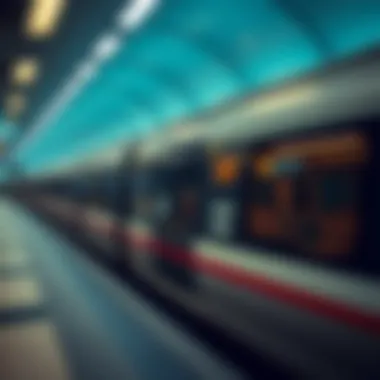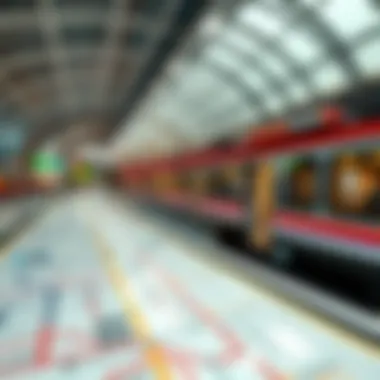Navigating Dubai's Metro: Schedules and Insights


Intro
Dubai's dynamic atmosphere is often reflected in its transport systems, not least with its metro. The Dubai Metro stands as a beacon of modern urban planning, weaving through the city with precision while offering unparalleled connectivity and convenience. It's not merely a mode of transport; it’s a window into understanding the broader aspects of life in this glittering metropolis. Comprehending the metro’s schedules and how they interlace with daily life holds significance for anyone living in or visiting the city.
The operational hours extend from early morning to late at night, which caters to the demands of locals and tourists alike. But it goes beyond practicality. The timings and frequency of the metro impact real estate values across Dubai. For investors, this is not just a transport system; it’s a fundamental pillar of urban infrastructure that affects property appeal and accessibility.
This article will take a closer look at how the Dubai Metro operates, the implications of its schedules, how it shapes life in the city, and its effects on real estate market trends.
Market Trends and Analysis
Current Market Conditions
Understanding the landscape of the Dubai Metro's influence on the property market requires a dive into current conditions. As of late 2023, the metro system continues to expand, recently adding new lines and stations, making more areas accessible. This development has sparked interest among real estate investors seeking properties adjacent to metro stations.
- Residential Areas Near Metro Stations: Neighborhoods like Dubai Marina, Burj Khalifa, and Jumeirah Lakes Towers see prices inflated due to accessibility.
- Commercial Spaces: Office spaces near metro hubs are in high demand, contributing to increased rental yields.
Future Projections and Opportunities
As the Dubai Metro plans additional expansions, it opens doors to future growth in property investments.
- Emerging Areas: Potential hotspots include areas like Al Quoz and Dubai South, which will intersect with new metro lines.
- Sustained Growth: The FIFA World Cup in 2023 and Expo 2025 are anticipated to drive more tourists, subsequently influencing property demand.
According to recent reports, properties within 500 meters of a metro station experience price appreciation of up to 15% annually due to increased accessibility.
Investment Strategies
Best Areas for Investment
Navigating the Dubai real estate market can be daunting. Here’s where the metro comes in as a guiding light. The best areas to focus on include:
- Dubai Marina: A hub for expatriates given its near sea proximity and metro access. High rental yields are typical.
- Business Bay: Its central position allows for prime office space opportunities and professional living arrangements.
- Downtown Dubai: Known for iconic landmarks, this area attracts high-end buyers and investors.
Tips for Property Investors
For those keen on investing in properties around metro stations, consider these strategies:
- Research Thoroughly: Stay updated on any new metro announcements to identify future investment opportunities before their popularity spikes.
- Accessibility is Key: Prioritize properties with easy access to metro services, as convenience is a selling point.
- Analyze Rental Trends: Look into the rental market in areas surrounding metro stations to gauge potential returns.
Dubai is evolving, and so should your investment strategies. By understanding the leverage that metro schedules provide, investors can navigate the market with clarity and purpose.
Prologue to the Dubai Metro
The Dubai Metro stands as a cornerstone of the city's public transportation network. It is heralded for its efficiency and reliability, often serving as the lifeblood of urban mobility in the bustling metropolis. Understanding the Dubai Metro is crucial for various stakeholders, including commuters, real estate investors, and tourists alike. It’s more than just a means to get from point A to B; the metro symbolizes the rapid growth and modernization that Dubai has embraced over the years.
Historical Background


The inception of the Dubai Metro dates back to the early 2000s when urban planners envisaged a system that would alleviate traffic congestion in a city that was rapidly expanding. The first line, the Red Line, was inaugurated in September 2009. During its initial years, this metro system proved to be a transformative force, facilitating transportation across the core of the city. By 2010, the Green Line was opened, further enhancing connectivity.
Dubbed one of the largest and most advanced automated metro systems in the world, it serves a dual purpose: it caters to a diverse population, including locals and expatriates, and significantly contributes to reducing the city’s carbon footprint. With over 75 kilometers of track and multiple stations, the Dubai Metro reflects a substantial commitment to sustainable urban development.
Importance in Urban Mobility
The significance of the Dubai Metro in the urban mobility landscape cannot be overstated. Riding the metro offers numerous advantages: it’s efficient, cost-effective, and a stress-free way to navigate the sprawling city. Here are several key points illustrating its importance:
- Accessibility: With strategically located stations, the metro provides easy access to major shopping centers, business districts, and tourist attractions, making it indispensable for residents and visitors alike.
- Time-Saving: The metro is often a preferable alternative to driving, particularly during peak hours. It operates on time, helping commuters avoid the headaches associated with traffic jams.
- Environmental Impact: The use of public transportation helps reduce vehicle emissions, contributing to cleaner air in Dubai and aligning with the city’s vision of enhancing sustainability.
- Economic Catalyst: By connecting neighborhoods and improving accessibility, the metro indirectly boosts local economies. Businesses located near metro stations often experience increased foot traffic.blockquote
Understanding the operational dynamics of the Dubai Metro can lead investors to make informed decisions regarding property value and urban planning.
Ultimately, the Dubai Metro is more than transport; it forged a new path for urban living, helping shape the very fabric of modern Dubai. Each journey taken on the metro enhances one’s understanding of the city’s growth and sustainable future.
Operational Hours of the Metro
The operational hours of Dubai Metro stand as a linchpin in the city’s public transportation system, facilitating smooth mobility for both residents and visitors. Understanding these hours is not just a matter of convenience; it’s about optimizing the daily commute and making informed travel decisions. The timings affect not only the movement of people but also influence business operations, tourism patterns, and even real estate dynamics within the area.
Efficiently navigating the metro schedule can save one’s time and enhance the overall experience of traveling in a bustling metropolis like Dubai. Furthermore, this knowledge can empower investors and property buyers to make smarter decisions that align with peak travel times and accessibility considerations when choosing the ideal location for future projects or residence.
Weekday Service Schedule
On weekdays, the Dubai Metro operates from 5:00 AM to midnight. This timetable is crucial for many professionals commuting to their jobs and students heading to classes. The first train departs at 5:00 AM, and with frequent services during rush hours, the intervals generally range from 2 to 5 minutes. Therefore, an early bird can easily use metro services before heading to work, which is a significant advantage compared to other forms of transport that might be less reliable at such early hours.
The predictability of the weekday service schedule is a lifeline for many who depend on timely transit to fulfill their daily responsibilities.
Weekend and Holiday Schedules
During the weekends and public holidays, the Dubai Metro adopts a slightly altered schedule. On Fridays, it operates from 10:00 AM to midnight, allowing individuals a late start after the workweek. On Saturdays and Sundays, the metro returns to its usual weekday hours of 5:00 AM to midnight. Understanding these unique timings is essential for planning leisurely days in the city or attending events. While it may seem less frequent than weekday services, adequate notice allows for strategic planning around these hours, ensuring one can make the most of their weekend adventures.
Peak vs. Off-Peak Hours
Commuters in Dubai Metro often battle it out for a spot during the peak hours of 7:00 AM to 9:00 AM and 5:00 PM to 8:00 PM. During these times, train frequencies might increase, but so does the number of passengers. Therefore, those seeking a peaceful ride or perhaps concerned about social distancing should consider avoiding these bustling hours. Conversely, off-peak hours generally occur mid-morning and mid-afternoon, where trains operate at wider intervals, roughly every 10 to 15 minutes. Opting for these times could offer a more relaxed and pleasant commuting experience.
In listing these patterns, many tend to overlook how widely they can affect real estate choices. Investors might look for properties that are near major metro stations, as accessibility during off-peak hours could attract tenants, ensuring a steady stream of potential renters or buyers. Understanding peak and off-peak timings provides valuable insight for anyone looking to invest in property closely connected to transit services.
Influencing Factors of Metro Timings
Understanding the influencing factors behind the metro timings in Dubai gives a clearer picture of how this integral transport system aligns with the city’s evolving demands. In this section, we will explore various aspects that dynamically adjust the operations of the metro network, thus reflecting the diversity in commuter habits and urban activities. This analysis not only serves to inform users about the best times to travel but also highlights how these timings can impact business strategies for real estate investors and agents.
Passenger Demand Patterns
Passenger demand is a pivotal component determining metro timings. It varies due to several influences, including work hours, school schedules, and recreational activities. For instance, during weekdays, the highest passenger volumes occur during the morning and early evening rush hour, primarily driven by commuters traveling for work. Conversely, weekends witness different patterns; the metro sees increased traffic around major shopping areas and entertainment spots. This shift emphasizes the need for adaptive scheduling that accommodates fluctuations in patronage.
Understanding these patterns can enhance user experience and operational efficiency. By monitoring peak usage times, metro authorities can adjust their services accordingly, providing more frequent trains during busy hours and maintaining cost-effectiveness during quieter periods. This not only makes the ride smoother for daily commuters but also offers an insight for real estate enthusiasts to discern which neighborhoods may benefit more in terms of residential demand due to their accessibility to transportation.


Seasonal Variations
Seasons in Dubai carry distinct characteristics that also influence metro operations. For instance, during the hotter months, particularly from June to September, both locals and expatriates tend to stay indoors, leading to a noticeable dip in commuter traffic. The metro timings are adjusted slightly during these periods, with services potentially reduced to coincide with the lower demand.
On the other hand, during the milder winter months, especially between November and April, tourist numbers soar. Extended metro hours may be implemented to accommodate the influx of visitors exploring the city’s attractions. Seasonal festivals and events, such as the Dubai Shopping Festival, further accentuate these variations, where additional trains may be added to cater to heightened demand. Understanding these cyclical changes aids real estate investors as they assess the vibrancy of different districts based on seasonal population shifts.
Event-Based Adjustments
Lastly, event-based adjustments play a significant role in shaping metro timings. Major events such as concerts, exhibitions, and sporting occasions can dramatically influence passenger volumes. For example, when a large-scale concert is set to take place at the Dubai Opera, the metro authority may extend operating hours, increase train frequency, and distribute additional staff to assist with crowd management.
Such strategic planning underscores the metro system's responsiveness to major happenings in the city, making it a reliable mode of transport for both residents and visitors. Investors and business professionals should pay attention to these event-based adjustments, as proximity to major venues linked with event schedules can enhance property values and demand for rentals. By examining the intersection of real estate and metro timings, stakeholders can better gauge investment opportunities and shape their strategies accordingly.
"Understanding the timings of the metro is not just about catching a ride; it's about grasping the pulse of Dubai itself."
Overall, recognizing and analyzing these influencing factors cultivates a deeper understanding of Dubai's metro system, allowing users to navigate their commuting needs more effectively while providing invaluable insights to those involved in real estate development and investment.
Practical Implications for Users
Understanding the operational nuances of the Dubai Metro isn't just an academic exercise; it's a roadmap for effective navigation through one of the most dynamic cities in the world. For commuters, investors, and expatriates alike, having a grasp of these practical implications can greatly enhance daily life. The metro system not only serves as a backbone for urban mobility but also offers insights into the real estate landscape, making it essential for users to tailor their commuting strategies accordingly.
Commuting Strategies
In a city like Dubai, where the heat can be oppressive and traffic frustrations common, the metro stands out as a reliable alternative. Mastering the ins and outs of the Dubai Metro can save time and money for those living and working in this bustling metropolis. Here are a few key commuting strategies:
- Timing Your Travel: Targeting off-peak hours can result in a much smoother ride. The morning rush hour from 7:00 a.m. to 9:00 a.m. and evening peak times from 5:00 p.m. to 7:00 p.m. can see trains packed to the gills. It’s wise to plan your trips either early in the morning or later in the afternoon to dodge the throngs.
- Selecting the Right Route: The metro system is designed for optimal connectivity. Prior to your journey, familiarize yourself with the routes and stations, particularly the key interchange points such as Union and BurJuman, which allow seamless transfers between lines. Knowing where to hop off can save you from unnecessary detours.
- Integrating Other Transport Options: Dubai’s metro allows for easy integration with other transportation modes. Using taxis or buses can be effective for the last mile after disembarking from the metro. This combination creates a comprehensive travel plan, ensuring you reach your destination efficiently.
Choosing the Right Travel Times
Knowing when to hop on the Dubai Metro can be just as important as knowing how to navigate it. Specific travel times can either enhance or detract from your commuting experience. Consider these factors:
- Avoiding Weekends for Business Travel: If traveling for business, aim to move during weekdays. While weekend schedules are more relaxed, many stations can become less busy on Fridays, around prayer times, leading to puzzling delays in getting to where you need to go.
- Aligning with Events: Major events or festivals in Dubai can significantly impact metro traffic and service availability. Keep an eye on the city’s event calendars to strategize your travel plans.
- Regularly Check Schedules: Sometimes, service alterations occur without warning. Have a reliable resource, such as the official RTA website, to consult for the latest operational hours.
Mastering the Dubai Metro schedules not only aids in commuting but also serves as a critical factor in understanding regional property values. For real estate investors, everything from transportation accessibility to peak travel times plays a role in strategic property investments.
As you navigate the urban tapestry of Dubai, remember that each ride on the metro offers an opportunity to engage with the city's rhythm, making informed choices about your travel can streamline your journey in this vibrant metropolis.
Impact of Metro Accessibility on Real Estate
The relationship between metro accessibility and real estate is an essential aspect in any urban setting, notably in a rapidly developing city like Dubai. As the metro system expands its reach, it effectively reshapes the urban landscape, unlocking potential opportunities for property investors and residents. Understanding this synergy offers strategic insights into how metro times can translate into value for real estate.
Property Values and Metro Proximity
In real estate, location is a key player, and proximity to the metro can significantly influence property values. Homes and commercial spaces that are within walking distance of a metro station often command higher prices. This trend is observed globally, but it’s particularly pronounced in Dubai, where transportation convenience is a high priority for many buyers and renters.
Access to the metro not only streamlines commuting but also enhances the appeal of properties in the vicinity. For instance, neighborhoods such as Dubai Marina and Jumeirah Lake Towers have seen property values soar, largely due to their proximity to metro stations. Savvy investors often look at metro maps before making property decisions, knowing that new or planned expansions could lead to future appreciation of property values.


- Key Benefits of Proximity to Metro:
- Convenient Commute: Shorter travel times appeal to professionals who value time.
- Higher Demand: Properties near metro stations attract more interest from buyers and tenants.
- Increased Property Values: Evidence shows a positive correlation between accessibility and property price increases.
"Living near a metro station doesn't just save time; it can also save money in the long run, as property values often reflect the convenience of urban public transport."
Emerging Neighborhoods Linked to Metro Expansion
As the Dubai Metro adds new lines and stations, it stimulates growth in previously underdeveloped areas. This trend is particularly evident in neighborhoods that are newly connected or are in the pipeline for future metro access. Areas such as Dubai South and Al Furjan are examples of neighborhoods flourishing due to metro advancements. Investors are keen to keep their eyes on these emerging regions, as a new metro station can catalyze development in the surrounding area, leading to a surge in both residential and commercial projects.
Furthermore, urban planners and developers are increasingly designing projects with metro accessibility in mind, knowing it enhances the desirability of their developments. As businesses and amenities proliferate in these neighborhoods, the demand for housing increases, further driving up property values.
- Prospective Areas Worth Watching:
- Dubai South: Poised for growth, especially with the expansion plans promoting connectivity.
- Al Furjan: New developments capitalizing on metro access attract families and investors alike.
Future Developments in Metro Services
The future of the Dubai Metro looks bright and promising, with a host of developments on the horizon that are set to transform the city's transport landscape. Understanding these changes is crucial for investors and real estate enthusiasts who wish to leverage the ongoing expansions for potential gains. As the city continues to grow, adapting to the increasing demands of a burgeoning population and tourism, enhancements to the metro services stand out as a key area of focus.
System Expansions and New Routes
Expansion of the Dubai Metro is not just about adding new trains or infrastructures; it's about reshaping how residents and visitors perceive and utilize urban mobility. Here are several aspects worth noting:
- Increased Coverage: New routes are planned to connect underserved areas of Dubai, improving accessibility. For instance, proposals to extend the Red Line towards Dubai World Central are in the pipeline, which could serve both residential and commercial hubs.
- Enhanced Capacity: With the anticipated growth in passenger numbers, the plans include increasing the frequency of trains, eliminating long waiting times during peak hours. This is particularly crucial as Dubai welcomes more global events.
"Investing in mobility is tantamount to investing in the future of a city. Metro expansions will not only alleviate congestion but foster economic opportunities."
- Technical Innovations: Incorporation of state-of-the-art technology in the new routes will also streamline operations and enhance passenger safety. The emphasis on smart transport solutions will bring efficiency to the forefront, attracting more users.
- Land Development: These expansions usually come hand-in-hand with new real estate projects. Developers are likely to maximize the potential of land adjacent to new metro stations, driving up the demand for both residential and commercial properties.
Integration with Other Transport Systems
A cohesive transport network is essential for any major city, and Dubai is working towards an integrated system that ties the metro more closely with other modes of transport. This integration will afford users a streamlined travel experience:
- Connecting Modes: New interchanges are being established with tram lines and bus networks, minimizing the hassle of transfers. For instance, the future integration of the metro with the Dubai Tram system will optimize transit times.
- Accessibility Improvements: Future developments aim to ensure that transfers between different modes of transport are user-friendly, particularly for elderly passengers and those with disabilities. Efforts are underway to enhance accessibility features at interchange stations.
- Unified Payment Systems: The idea of a common payment system across various transport modes is being explored. This would simplify transactions for commuters, allowing seamless travel across the entire public transport network without the need to juggle multiple fare cards.
- Sustainability Goals: As more emphasis is placed on green transportation, integrating metro services with sustainable options, including electric buses and bike-sharing programs, will become vital to the strategic plan of Dubai's transport policy.
In summary, the future developments in metro services are poised to not only enhance the efficiency and reach of Dubai's public transport but also to positively impact the real estate market. Investors should pay close attention to these changes, as they could offer significant benefits in terms of property values and urban development opportunities.
Epilogue
In wrapping up this exploration of Dubai’s metro timings, it's clear that this subject holds immense significance not only for daily commuters but also for real estate investors and urban planners. Understanding how the operational hours of the metro interweave with the city’s broader transport network can determine how smoothly one navigates through the bustling metropolis.
Key Takeaways
- Operational Insights: The metro's weekday and weekend schedules cater to diverse passenger needs, ensuring that whether you’re an early bird or a night owl, there’s always a train waiting to whisk you away. This flexibility is crucial for professionals who depend on punctuality in their working lives.
- Impact on Property Values: Proximity to metro stations dramatically influences real estate prices. Properties near metro lines tend to appreciate more quickly, making them attractive investments. As urban development strategies evolve, savvy investors should prioritize areas predicted to welcome new metro expansions.
- Changing Patterns: Passenger demand greatly influences operational adjustments. Increased footfall during events or holiday seasons can lead to extended hours, showcasing the metro's adaptability. Tracking these trends can provide invaluable forecasting data for those involved in real estate.
- Integrative Transport Strategy: Future developments hint at a seamless integration with buses and taxis, streamlining user experiences across various platforms. This unified approach is essential for reducing congestion and enhancing urban mobility.
To encapsulate, diving into the nuances of the metro timings in Dubai reveals strategic insights that extend beyond a mere understanding of transport. The information gathered here equips investors, agents, and urban explorers with the knowledge needed to make informed decisions, ensuring they stay ahead in a rapidly evolving metropolitan landscape.
"A well-connected city is a thriving city; understanding its pulse enhances the navigation through its urban fabric."
For more information, you can refer to these useful links:
- Dubai Metro Official Website
- Dubai Land Department
- Public Transport in Dubai - Wikipedia
- Urban Planning in Dubai – Britannica











